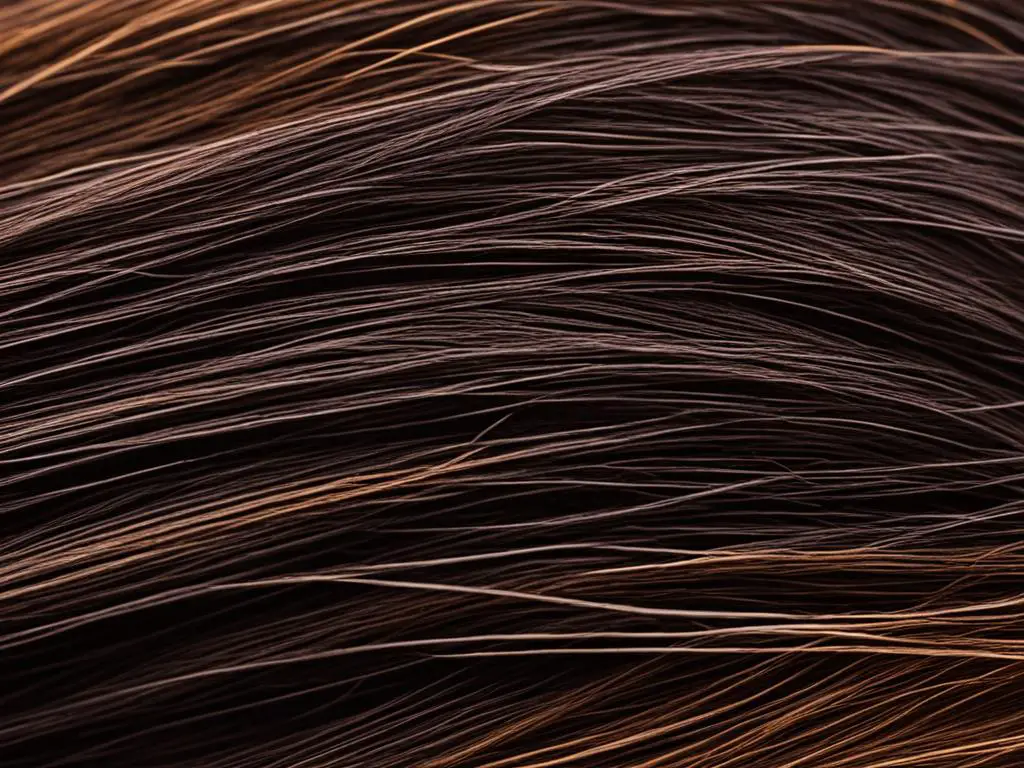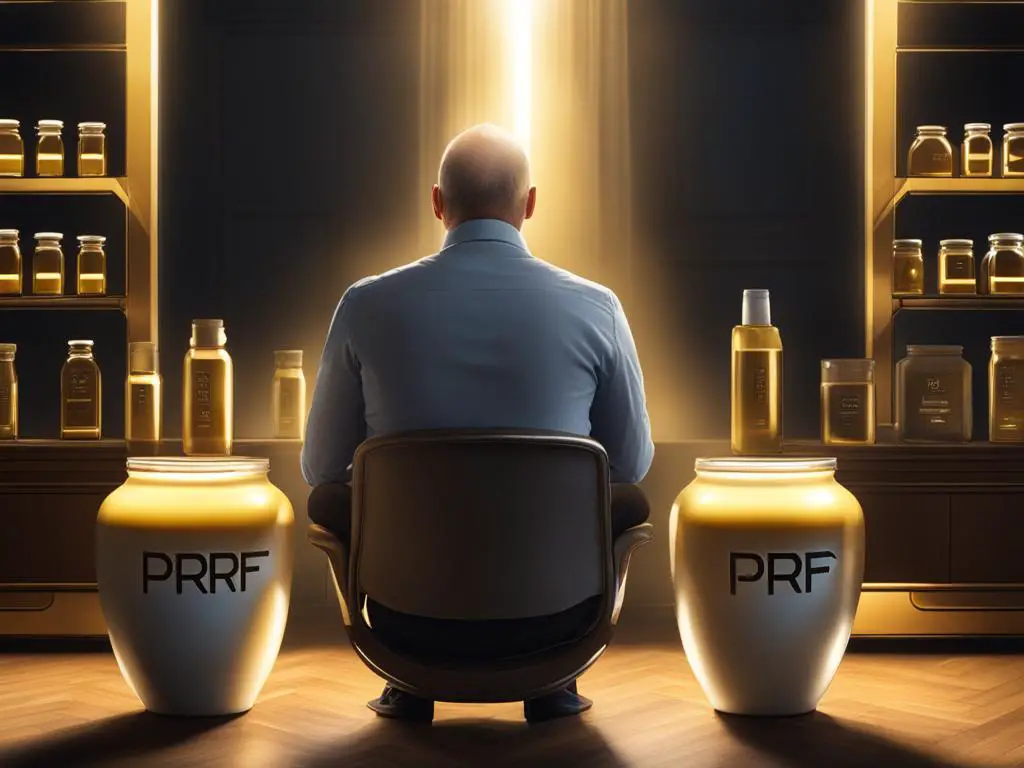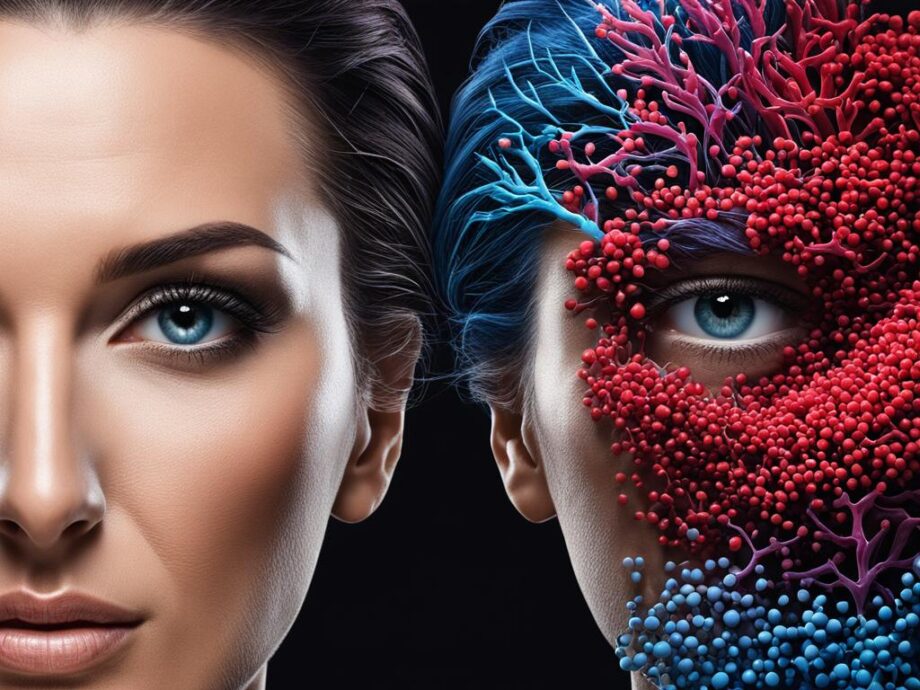Hair loss affects millions of people globally, and it can have a significant impact on self-esteem and confidence. Fortunately, there are various hair restoration options available, including regenerative treatments such as PRP (platelet-rich plasma) and PRF (platelet-rich fibrin).
While PRP and PRF treatments have gained popularity in recent years, many individuals are still unsure about which option may be the best choice for them. In this section, we will compare PRP vs PRF for hair restoration and explore their effectiveness as regenerative treatments for hair loss. We will analyze the benefits, procedures, and potential outcomes of each to help individuals make an informed decision about which choice may be suitable for their specific hair loss concerns.
Key Takeaways
- PRP and PRF are popular regenerative treatments for hair loss.
- Both treatments involve using the patient’s own blood to promote hair growth and enhance hair health.
- PRP and PRF differ in their concentration levels, preparation methods, and potential outcomes.
- Comparing the benefits, procedures, and potential outcomes of each treatment can help individuals make an informed decision about which option may be the best choice for them.
- It is important to consult with a qualified professional to determine which hair restoration option may be suitable for your specific needs and concerns.
Understanding PRP for Hair Growth
Platelet-rich plasma (PRP) is a promising treatment for hair growth. This regenerative therapy involves injecting a concentrated amount of platelets from the patient’s blood into the scalp. The platelets contain growth factors that stimulate hair follicles, promoting hair growth and thickness.
The PRP procedure for hair rejuvenation typically involves multiple sessions. During each session, blood is drawn from the patient and spun in a centrifuge to separate the platelet-rich plasma from the rest of the blood components. The PRP is then injected directly into the scalp, and the patient can resume their daily activities with minimal downtime.
Studies have shown that PRP for hair growth can be effective in stimulating hair regrowth and improving hair density. Although individual results may vary, many patients have reported noticeable improvements in hair quality and volume after several PRP sessions.
The Benefits of PRP for Hair Growth
- Non-Surgical: Unlike hair transplant surgery, PRP for hair growth is a non-surgical, minimally invasive procedure.
- Safe: PRP therapy uses the patient’s own blood, minimizing the risk of adverse reactions or infections.
- Effective: PRP has shown promising results in stimulating hair regrowth, improving hair thickness, and promoting overall hair health.
- Minimal Downtime: The PRP procedure is quick and requires minimal downtime, allowing patients to resume their daily activities soon after treatment.
“I’ve been struggling with hair loss for years and have tried various treatments, but PRP has by far been the most effective. My hair feels thicker, and I’ve noticed new hair growth in areas where I previously had thinning. I highly recommend PRP therapy for anyone looking to improve their hair health.” – Samantha, PRP patient
Exploring PRF for Hair Regrowth
In the world of hair restoration, PRF is a relatively new player that has created quite a buzz. PRF stands for Platelet-rich Fibrin, which is an advanced version of PRP therapy. It is derived from a patient’s own blood and contains growth factors, platelets, and white blood cells that are essential for stimulating hair growth. Unlike PRP, which only contains platelets, PRF is a more concentrated formula that helps to accelerate the regeneration process.
The key difference between PRP and PRF is that PRF uses a specially-designed centrifuge that separates the blood components based on their density. This allows for the extraction of a denser, fibrin-rich layer of plasma that is more effective in promoting hair growth. Additionally, PRF contains more platelets than PRP, making it more potent and efficient.
The use of PRF in hair restoration has been proven effective in multiple studies, with some reporting a 34% increase in hair density after just three sessions of treatment. PRF has also shown promising results in preventing hair loss by strengthening hair follicles and enhancing blood supply to the scalp.
When it comes to PRF therapy, patients can expect minimal discomfort and downtime. The procedure typically involves a simple blood draw, after which the blood is processed through the centrifuge machine and then injected into the scalp using microneedles. Most patients will notice visible improvements in hair growth and thickness within 3-6 months of treatment.
Overall, PRF is an excellent hair restoration option for those looking to regrow their hair naturally. Its high concentration of platelets and fibrin makes it a potent regenerative treatment that can promote healthy hair growth. With its minimal downtime and painless procedure, PRF is a viable option for anyone looking to restore their hair’s fullness and vitality.
PRF vs PRP for Hair Restoration
| Platelet-Rich Plasma (PRP) | Platelet-Rich Fibrin (PRF) |
|---|---|
| Contains platelets and growth factors that promote hair regrowth | Contains a more concentrated formula of platelets, growth factors and fibrin |
| Takes less time to produce | Requires slightly more time to process due to centrifugation |
| More suitable for less severe hair thinning or as a preventive measure | More effective for thinning hairlines and severe hair loss |

Comparing the Effectiveness of PRP and PRF for Hair Restoration
PRP and PRF are two of the most popular regenerative treatments for hair loss. Both therapies use blood-derived plasma to stimulate growth and restore follicles. But which one is more effective? Let’s take a closer look.
PRP for Hair Restoration
PRP involves drawing blood from the patient’s arm, then using a centrifuge to separate the platelet-rich plasma from the rest of the blood cells. The PRP is then injected into the scalp, with the objective of activating growth factors and increasing blood flow to the hair follicles.
“PRP for hair restoration has become an increasingly popular treatment option due to its effectiveness in stimulating hair growth and improving thickness.”
Studies have shown that PRP can enhance hair growth, thickness, and density for individuals facing hair loss concerns. The results are particularly noteworthy for individuals with androgenic alopecia, a condition that affects up to 50% of men.
PRF for Hair Restoration
PRF is a new and innovative treatment option for hair restoration that utilizes fibrin instead of plasma. Fibrin is a protein found in blood that plays a critical role in the clotting process. Similar to PRP, PRF involves drawing blood from the patient’s arm and applying centrifugation to extract the fibrin.
“PRF is a promising alternative to PRP, offering patients a regenerative treatment option with a reduced risk of allergic reaction.”
PRF can help restore hair follicles by stimulating hair growth and minimizing inflammation. Unlike PRP, PRF contains additional growth factors and white blood cells, which can enhance the healing process and minimize the risk of allergic reactions.
| PRP | PRF |
|---|---|
| Uses platelet-rich plasma | Uses platelet-rich fibrin |
| Requires a higher concentration of platelets | Contains additional growth factors and white blood cells |
| May cause side effects such as allergic reactions | May have reduced risk of allergic reactions |
| Can be used in conjunction with hair transplantation | Has been shown to improve hair growth and thickness |
As indicated in the table above, there are distinct differences between PRP and PRF, with both treatments offering unique advantages and limitations in the context of hair restoration.
Overall, studies have found PRP to be an effective hair restoration option. However, PRF offers a promising alternative, with a reduced risk of allergic reaction and a higher concentration of growth factors and white blood cells. Ultimately, the choice between PRP and PRF depends on the individual’s unique hair loss concerns and the advice of a qualified dermatologist or hair restoration expert.

Benefits of PRP and PRF for Hair Restoration
Platelet-rich plasma (PRP) and platelet-rich fibrin (PRF) are two regenerative treatments that offer a multitude of benefits for hair restoration. These treatments work by stimulating the growth of new hair, improving hair texture and thickness, and enhancing overall hair health. Here are some of the key benefits of both PRP and PRF:
| Benefits of PRP for Hair Restoration | Benefits of PRF for Hair Restoration |
|---|---|
| Improves hair thickness and texture | Stimulates regeneration of hair follicles |
| Helps hair grow faster and longer | Enhances overall scalp health |
| Reduces hair shedding and thinning | Addresses hormonal imbalances that cause hair loss |
| Non-surgical, minimally invasive treatment | Natural and safe, using the patient’s own blood |
Both PRP and PRF treatments are suitable for individuals with mild to moderate hair loss or thinning. These regenerative treatments are becoming increasingly popular due to their effectiveness and minimal side effects. By promoting hair growth and enhancing hair health, PRP and PRF can help individuals achieve long-lasting hair restoration results.
“PRP and PRF hair restoration treatments offer natural hair growth and improved hair health for individuals suffering from hair loss or thinning. These treatments stimulate hair growth and produce amazing results in a short period of time.”

Exploring Different Hair Rejuvenation Options
While PRP and PRF therapies are effective in hair rejuvenation, there are other non-surgical hair restoration treatments worth considering. Let’s take a look at some of these hair rejuvenation procedures:
Low-Level Laser Therapy (LLLT)
LLLT uses red or near-infrared light to stimulate hair growth. It is non-invasive and thought to work by increasing blood flow to the scalp, promoting hair growth and follicle development. While it is frequently used in combination with PRP or PRF, it can also be used on its own.
Nutrition and Supplements
A balanced diet with essential vitamins and minerals can help reduce hair loss and promote hair growth. Vitamin D, iron, biotin, and zinc are essential nutrients that promote healthy hair. Supplements are a good way to check that nutritional requirements are being met and can help prevent hair loss.
Neurolinguistic Programming (NLP)
NLP is a type of psychotherapy aimed at reducing stress and anxiety, both of which contribute to hair loss. By relaxing the mind, NLP can reduce the stress hormone cortisol, which can stimulate hair growth. While studies are limited, many people have reported positive results with NLP for hair loss prevention.
Hair Transplantation
Hair transplantation involves moving hair from areas of the scalp with hair to areas that are thinning or balding. It is a surgical procedure and can be invasive, but it can have long-lasting results. While it is often used as a last resort, it can be an effective solution for individuals with advanced hair loss.
With these hair rejuvenation options, you have different alternatives to consider outside of PRP and PRF. It’s important to research and consult with a hair restoration specialist to determine which procedure will best suit your specific hair loss concerns.
Understanding Hair Loss and Regenerative Treatments
Hair loss is a common concern for many individuals, and can be caused by factors such as genetics, aging, stress, and hormonal imbalances. While there are several hair restoration options available on the market, regenerative treatments for hair loss have gained significant attention in recent years.
Regenerative treatments work by utilizing the body’s natural healing process to stimulate hair growth, improve hair thickness, and enhance overall hair health. Platelet-rich plasma (PRP) and platelet-rich fibrin (PRF) are two regenerative treatments that have shown promising results in treating hair loss.
The Role of PRP and PRF in Hair Restoration
PRP and PRF work by extracting platelets from the patient’s own blood and injecting them directly into the scalp. These platelets contain growth factors that stimulate hair follicles and promote hair growth.
While PRP and PRF share similar benefits, PRF is believed to have a higher concentration of platelets and growth factors, potentially making it a more effective treatment option for hair loss.
Other Hair Restoration Options
In addition to PRP and PRF, there are other hair restoration options available for individuals experiencing hair loss. These include hair transplantation surgery, medications such as minoxidil and finasteride, and laser therapy. However, these options may come with various side effects and risks, making regenerative treatments like PRP and PRF a preferred choice for many individuals.
Conclusion
In conclusion, when it comes to hair restoration, PRP and PRF are both effective regenerative treatments. However, there are key differences between platelet-rich plasma vs platelet-rich fibrin for hair restoration.
Individuals experiencing hair loss should weigh the benefits and potential outcomes of each treatment before making a decision. PRP for hair growth can provide an overall improvement in hair health and thickness, while PRF for hair regrowth can target specific areas of hair loss.
While both treatments have shown promising results, it is essential to consult with a qualified professional to determine which treatment option may be most suitable for each individual.
With the help of these regenerative treatments, individuals can take a proactive approach to address their hair loss concerns and restore their confidence in their appearance.
FAQ
What is the difference between PRP and PRF for hair restoration?
PRP (platelet-rich plasma) and PRF (platelet-rich fibrin) are both regenerative treatments used for hair restoration. The main difference between the two lies in the composition and preparation process. PRP is derived from the patient’s blood and contains concentrated platelets, growth factors, and other healing components, while PRF is a fibrin-based gel that contains a higher concentration of platelets and leukocytes. Both treatments have shown promising results in promoting hair growth and improving hair thickness.
How does PRP work for hair growth?
PRP works by harnessing the healing and regenerative properties of platelets. The treatment involves drawing the patient’s blood, processing it to separate the platelet-rich plasma, and injecting it into the scalp’s targeted areas. The platelets release growth factors that stimulate hair follicles, promote blood circulation, and encourage the regeneration of new hair cells. This can lead to hair growth, improved hair quality, and reduced hair loss.
Can PRF help with hair regrowth?
Yes, PRF has shown potential in promoting hair regrowth. Similar to PRP, PRF stimulates hair follicles and encourages the growth of new hair cells. The higher concentration of platelets and leukocytes in PRF may provide enhanced healing and regenerative effects. The treatment involves extracting the patient’s blood, concentrating it further using specific centrifugation techniques, and injecting the resultant PRF gel into the scalp. PRF can help improve hair density, thickness, and overall hair health.
Which is more effective for hair restoration: PRP or PRF?
The effectiveness of PRP or PRF for hair restoration can vary depending on individual factors such as the extent of hair loss, underlying causes, and treatment response. Some studies suggest that PRP may provide more noticeable improvements in hair growth and thickness, while others indicate that PRF may deliver superior results due to its higher concentration of platelets and leukocytes. It is essential to consult with a qualified medical professional who can assess your specific hair loss concerns and recommend the most appropriate treatment option.
What are the benefits of PRP and PRF for hair restoration?
Both PRP and PRF offer several benefits for hair restoration. These treatments are minimally invasive, require no downtime, and can be performed as outpatient procedures. By stimulating hair follicles and promoting blood circulation, PRP and PRF can lead to improved hair growth, decreased hair loss, and enhanced hair thickness. Additionally, these regenerative treatments are safe, as they utilize the patient’s own blood components, reducing the risk of adverse reactions or allergies.
Are there other hair rejuvenation options besides PRP and PRF?
Yes, there are other non-surgical hair rejuvenation options available. One such option is Neurolinguistic Programming (NLP), which focuses on mindset and cognitive techniques to address hair loss and promote hair growth. NLP aims to reframe negative thought patterns and beliefs about hair loss and can be used in conjunction with other regenerative treatments for optimal results. It is advisable to consult with a hair restoration specialist to explore different options and determine the most suitable approach for your specific needs.
How do PRP and PRF fit into the realm of hair restoration options?
PRP and PRF hold significant potential in the field of hair restoration. These regenerative treatments offer a non-surgical and relatively safe alternative to more invasive options like hair transplants. By harnessing the healing properties of platelets and growth factors, PRP and PRF can stimulate hair follicles, improve hair growth, and restore hair thickness. However, it is important to note that the effectiveness can vary among individuals, and a comprehensive consultation with a hair restoration specialist is crucial to determine the most suitable solution.
In conclusion, which treatment is recommended for hair restoration: PRP or PRF?
The choice between PRP and PRF for hair restoration depends on individual factors and treatment objectives. It is advisable to consult with a qualified hair restoration specialist who can assess your specific needs, evaluate your medical history, and recommend the most suitable treatment option. By considering factors such as the extent of hair loss, underlying causes, and treatment response, you can make an informed decision that aligns with your desired outcomes and expectations.
